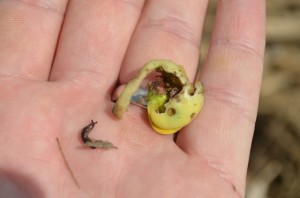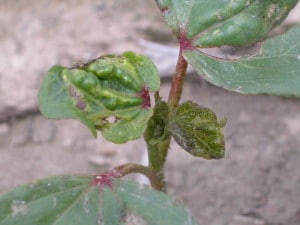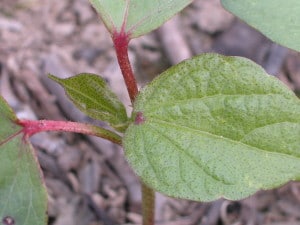My phone hasn’t been going crazy with critter calls, but slug injury has been the clear winner this week, both in cotton and soybean. I also want to put forth a few reminders about thrips in cotton.

Are you seeing mysterious holes on seedling plants and can’t find a critter? If you are in no-till, especially where high residue is present, it’s probably slug feeding. These rascals feed mostly at night and hide under debris or in cracks and crevices when the sun is out. People often blame snails (having shells), but slugs are almost always the real problem. They are just harder to find. In severe cases, slugs can reduce stand enough to force replanting, and there have been several reports of that this year. Often, the problem is reported following a previous corn crop or where a cover crop was used because this increases the residue in the field. So what can you do about it?
The primary controls for this pests are cultural, and hot and dry weather is also a big help. Generally, once the crop gets up to a good stand, it can tolerate the leaf feeding caused by slugs. The worst cases of injury often occur where stands were thin to begin with, it was a little to wet during planting, and the seed furrow did not close up well during planting. This creates a highway for slugs to feeding on plants even before they even emerge (day and night). Below are some things to think about to avoid serious slug problem.
- Tillage work great as slugs are almost exclusively a no-till problem. This is obviously not an option in many places, but even light tillage can make a dramatic difference.
- Burndown weeds well in advance of planting. This will help but is not a cure.
- Plant in conditions where you expect rapid emergence and don’t plant too wet. Make sure the seed are being well covered and the seed furrow is closing.
- If you know slugs are present, for example, where you have a lot of residue, increase your seeding rate 10-15%.
- When possible, setting row cleaners aggressively to throw debris away from the row will help tremendously. Seedling plants that are covered or partially covered with residue will suffer the worst (slugs will feed on them day and night). Often, the worst injury occurs where debris washes into low spots.
Insecticides will NOT kill slugs. There are metaldehyde (e.g., Deadline M-Ps) and iron-phosphate baits that work pretty well, but even the minimum rates are fairly expensive. The real challenge is finding product in time and getting it applied in quantities for large agricultural fields. These products need to spread like fertilizer, but at rates of 10-20 pounds per acre. My experience has been, that unless you have planned for the problem in advance, this approach will be too little and too late.

Thrips are the #1 problem of seedling cotton, and we have a lot of cotton ranging from just planted to 2-3 true leaves. Repeating some previous comments … our scouting efforts in cotton should focus on thrips until plants have 3-4 true leaves. As you know, thiamethoxam (Cruiser) in no longer recommended as a stand-alone seed treatment because of resistance in tobacco thrips populations. With uncertain levels of resistance to imidacloprid-based seed treatments (Gaucho, Acceleron, Aeris), it is important to watch fields carefully and make treatments as needed.

The additional insecticide component found in Aeris (thiodicarb) definitely improves thrips control. I’ve seen similar benefit from the avermectin component found in Avicta Elite Cotton Plus. There is also potential benefit to adding acephate (Orthene) to a base seed treatment of imidacloprid. If you only have imidacloprid on the seed, my suggestion is to plan on making an application at the 1-2 leaf stage. However, some professional judgment is needed. If the emerging first or second true leaves look relatively pristine, you will not benefit from an insecticide application in my experience. Insecticides including Acephate (Orthene), Bidrin, Dimethoate and Radiant are recommended options. Remember that NO insecticides are currently labeled for tank mixing with Engenia or XtendiMax.

